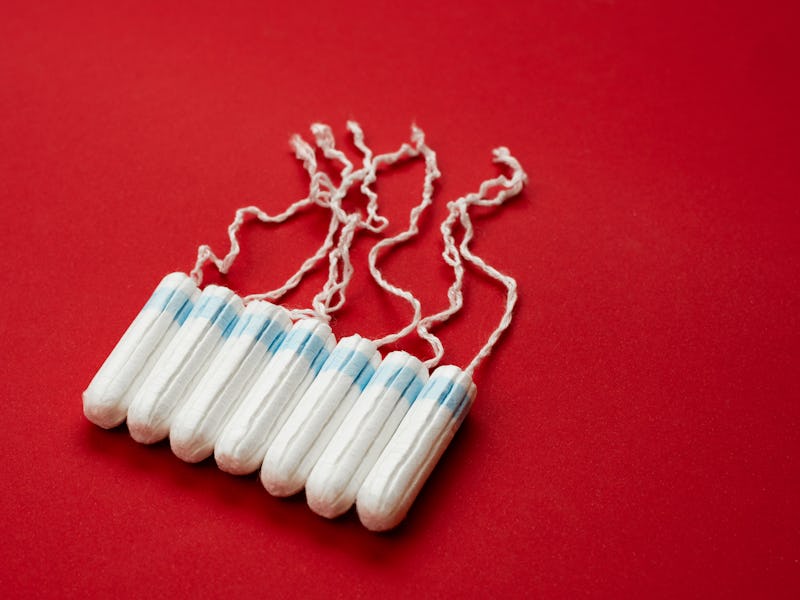Lead, Arsenic, and Other Toxic Metals are Lurking in Commonly Purchased Tampons
Not all of these compounds are inherently harmful — here’s what you need to know.

About half of all people on Earth menstruate at some point in their lives, and many of them manage their monthly periods with tampons. Yet new research suggests some worrying compounds are likely hiding inside those fiber wads. Detectable concentrations of 16 different metals and metalloids, some of which are toxic, have been found in widely used tampons, carried by major brands and retailers in the U.S., UK, and Europe, according to a study published June 22 in the journal Environment International.
The researchers tested 60 samples of 30 individual tampons, from 14 brands and 18 product lines. Using mass spectrometry, they assessed concentrations of arsenic, barium, calcium, cadmium, cobalt, chromium, copper, iron, manganese, mercury, nickel, lead, selenium, strontium, vanadium, and zinc contained within the tampon cores and outer linings. They found that 12 of the metals were present in detectable levels in 100 percent of the samples. Of the remaining four compounds, mercury and chromium were present only in a handful of the samples, but arsenic and selenium were present in upwards of 95 percent of the tampons.
Not all of these compounds are inherently harmful. In fact, iron, calcium, manganese, copper, zinc, nickel, and selenium are all essential nutrients that your body needs in some form and amount (for most of the above, a very small amount) to function. But that doesn’t mean potential exposure to these minerals through tampons is a good thing. Too much of a trace mineral can cause problems, the chemical form found in tampons may not be quite what the human body needs, and exposure route can change how compounds are processed.
Even absorbing or ingesting small amounts of these metals and metalloids can lead to serious negative health effects, such as increased risk of certain cancers, heart disease, and kidney damage.
Then there's another group of items on the test list. Arsenic, cadmium, chromium, mercury, lead, and vanadium — sometimes referred to as “heavy metals” — are all toxic metals or metalloids. Even absorbing or ingesting small amounts of these metals and metalloids can lead to serious negative health effects, such as increased risk of certain cancers, heart disease, and kidney damage. For compounds like lead, which can cause reproductive difficulties, high blood pressure, and cognitive issues in adults, there’s no amount considered “safe.”
“Although toxic metals are ubiquitous and we are exposed to low levels at any given time, our study clearly shows that metals are also present in menstrual products,” said study co-author Kathrin Schilling, a geochemist and assistant professor of environmental health at Columbia University, in a press statement. “Women might be at higher risk for [toxic metals] exposure using these products,” she adds.
The study compared tampon brands, organic versus non-organic products, and the location of purchase. They found some differences between brands, organic designation, and location, but none of the tested tampons were without metal contamination.
The study did not directly evaluate human health risk or absorption of these minerals through tampon use. More research is needed to know if the metals are leaching out of tampons, if they’re being absorbed by tampon users, and if the level of absorption poses a risk. “We cannot speculate on potential harm to the health of menstruators,” write the study authors. “It is critical that future studies evaluate the potential for metal leaching from tampons and uptake into the body.” However, the mere presence of toxic metals in a product meant to be inserted into the vagina is worrying.
The vaginal lining is an especially permeable mucus membrane. A high concentration of blood vessels and tiny folds that add surface area mean the vagina is much more absorbent than skin elsewhere on the body. Plus, compounds absorbed vaginally don’t pass through the liver’s filtration system. Though little work has been done assessing the vaginal lining as a route for toxin exposure, previous studies have highlighted how pharmaceuticals can be delivered vaginally — in some instances more effectively than through oral routes.
Where, exactly, the metals in the tested tampons originate from is still unknown, though the study researchers have hypotheses. Tampons are mostly made of materials like cotton, rayon, and viscose–all of which are at least partially derived from plant materials. Many crops are known to uptake heavy metals from soil, water, fertilizers, and pesticides. It could be that contaminants are sequestered by the plants used in tampon manufacture. This possibility is bolstered by the finding that arsenic levels were generally higher in the tested organic tampons, which were all 100 percent cotton, compared to the non-organic products, which were often a blend. Cotton plants are known to absorb arsenic from their environment.
It’s also possible that certain metals are added to menstrual products as part of processing– potentially as whiteners, pigments, lubricants, odor reducers, or antimicrobial agents. For instance, compared with studies of textiles, the levels of zinc found in the tested tampons was especially high. The study authors suggest this indicates manufacturers may be intentionally putting zinc into tampons for odor control or another purpose.
These early findings don’t necessarily mean your favorite menstrual products are unsafe. The researchers hope more studies and tests will bring clarity. If future assessments do demonstrate a risk, the study authors suggest more oversight is in order. “Our findings point towards the need for regulations requiring the testing of metals in tampons by manufacturers,” they write. Currently, though the Food and Drug Administration (FDA) regulates tampons as medical devices, the agency doesn’t test tampons for chemical contaminants.
"We plan to evaluate the study closely and take any action warranted to safeguard the health of consumers who use these products,” an FDA spokesperson told CBS News.